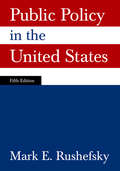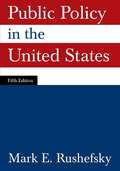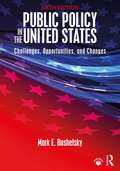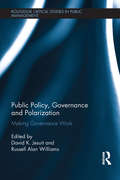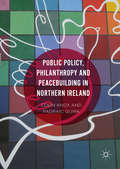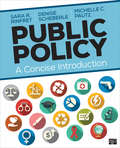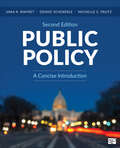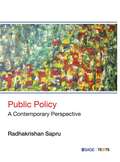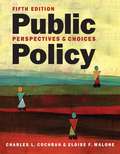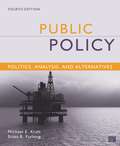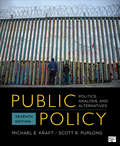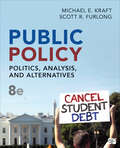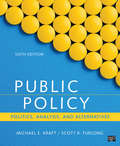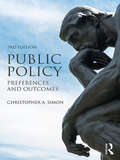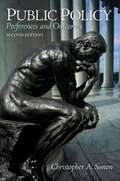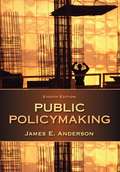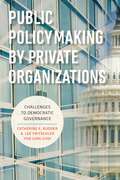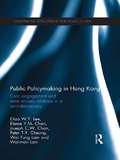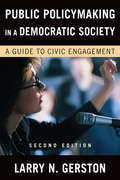- Table View
- List View
Public Policy in the United States
by Mark E RushefskyThe fifth edition of this well-regarded text covers the period up through the 2012 elections. It has been revised to make it sleeker, more concise, and up-to-date with a clear organisational structure.This edition accomplishes these three important goals:First, it introduces readers to the American approach to public policy making as it has been shaped by our political institutions, changing circumstances, and ideology.Second, it surveys American public policy and policymaking in all the major policy areas from economic policy to health care policy to environmental policy, and does so clearly and even-handedly, with well-selected illustrations, case studies, terms, and study questions.Finally, in addition to providing analytical tools and empirical information, the book challenges readers to come to terms with the widely shared but often competing values that must be balanced and rebalanced in the ongoing policy making process, affecting issues of the highest concern to the American public.
Public Policy in the United States
by Mark E. RushefskyThe fifth edition of this well-regarded text covers the period up through the 2012 elections. It has been revised to make it sleeker, more concise, and up-to-date with a clear organisational structure. This edition accomplishes these three important goals: First, it introduces readers to the American approach to public policy making as it has been shaped by our political institutions, changing circumstances, and ideology. Second, it surveys American public policy and policymaking in all the major policy areas from economic policy to health care policy to environmental policy, and does so clearly and even-handedly, with well-selected illustrations, case studies, terms, and study questions. Finally, in addition to providing analytical tools and empirical information, the book challenges readers to come to terms with the widely shared but often competing values that must be balanced and rebalanced in the ongoing policy making process, affecting issues of the highest concern to the American public.
Public Policy in the United States: Challenges, Opportunities, and Changes
by Mark E. RushefskyOffering the widest breadth of policy issue coverage on the market, the sixth edition of this well-regarded text covers events through the 2016 elections and beyond. Though the content has been extensively and thoughtfully revised and updated, the sixth edition maintains its clear approach, without an overreliance on policy theory, and popular threefold structure: First, it introduces readers to the American approach to public policy making as it has been shaped by our political institutions, changing circumstances, and ideology. Second, it surveys all of the major policy areas from foreign policy to health care policy to environmental policy, and does so with well-selected illustrations, case studies, terms, and study questions. Third, it provides readers with analytical tools and frameworks to examine current problems and be able to understand and critique proposed public policy solutions. New to the sixth edition is an exploration of: The Affordable Care Act and its implementation, controversies, and impact The American economy since the end of the Great Recession, trade policy, and economic equality issues Foreign policy including relations with Russia, China, and Iran, as well as the civil war in Syria, the continuing conflicts in Iraq, and the challenge of ISIS The US Criminal Justice system and its incarceration challenges as well as issues of minorities, police, and crime. This new edition includes, for the first time, a test bank with multiple choice, short answer, and discussion/essay questions as well as an instructor’s manual. Public Policy in the United States, 6e is an ideal undergraduate text for introductory courses on American Public Policy and Politics, and can be used as supplementary reading in undergraduate courses on policy process, policy analysis, and American government.
Public Policy, Governance and Polarization: Making Governance Work (Routledge Critical Studies in Public Management)
by David K. Jesuit and Russell Alan WilliamsPolarization is widely diagnosed as a major cause of the decline of evidence-based policy making and public engagement-based styles of policy making. It creates an environment where hardened partisan viewpoints on major policy questions are less amenable to negotiation, compromise or change. Polarization is not a temporary situation – it is the “new normal.” Public Policy, Governance and Polarization seeks to provide a theoretical foundation for scholars and policy makers who need to understand the powerful and often disruptive forces that have arisen in Europe and North America over the past decade. Academics and practitioners need to better understand this growing trend and to find ways in which it may be managed so that policy solutions to these threats may be developed and implemented. Researchers and future policymakers in fields such as public administration, public management and public policy need to recognise how institutional design, corporatist interest group systems and different pedagogical approaches may help them understand, discuss and work beyond policy polarization. Edited by two leading political science scholars, this book aims to begin that process.
Public Policy, Philanthropy and Peacebuilding in Northern Ireland
by Colin Knox Padraic QuirkThis book examines the role playedby one important external stakeholder, Atlantic Philanthropies, a limited-lifefoundation, in helping to build peace and promote reconciliation in NorthernIreland. Northern Ireland is now referred to as a post-conflict society largelydue to the absence of political violence and relatively stable politicalinstitutions. These are necessary but insufficient conditions for what Galtunghas described as 'positive peace', which requires a more fundamental review ofthe structural inequalities that contributed to the conflict in the first place. Using detailed case studies the authors illustrate the role played by voluntaryand community sector groups, funded by Atlantic Philanthropies, in influencingthe public policy agenda and securing long term systemic changes. They alsocritique the work of Atlantic as a 'pay to play' organization whose originalmission moved from funding the higher education sector on the island of Irelandto become a key foundation with a significant role in the peace process.
Public Policy: A Concise Introduction (American Governance And Public Policy Ser.)
by Sara R. Rinfret Michelle C. Pautz Professor Denise L. ScheberlePublic Policy: A Concise Introduction, by Sara R. Rinfret, Denise Scheberle, and Michelle C. Pautz, is a student-friendly primer that quickly connects readers to the inner workings of public policy. The text condenses early chapters on theory and the policy-making process, allowing students to take up key policy challenges—such as immigration, education, and health care—much earlier in the semester. Structured chapter layouts of substantive policy areas allow instructors to supplement with their own examples seamlessly. The book’s emphasis on policy choices asks students to look beyond simple pros and cons to examine the multifaceted dimensions of decision making and the complexities inherent in real-world problem solving. Not every student starts out engaged in public policy, so place your students—both majors and non-majors alike—in the driver’s seat by fostering their analytical skills early, and spend the rest of the semester discussing policy issues, examining data, and debating current policy examples that matter most to them.
Public Policy: A Concise Introduction (American Governance And Public Policy Ser.)
by Sara R. Rinfret Michelle C. Pautz Professor Denise L. ScheberlePublic Policy: A Concise Introduction, by Sara R. Rinfret, Denise Scheberle, and Michelle C. Pautz, is a student-friendly primer that quickly connects readers to the inner workings of public policy. The text condenses early chapters on theory and the policy-making process, allowing students to take up key policy challenges—such as immigration, education, and health care—much earlier in the semester. Structured chapter layouts of substantive policy areas allow instructors to supplement with their own examples seamlessly. The book’s emphasis on policy choices asks students to look beyond simple pros and cons to examine the multifaceted dimensions of decision making and the complexities inherent in real-world problem solving. Not every student starts out engaged in public policy, so place your students—both majors and non-majors alike—in the driver’s seat by fostering their analytical skills early, and spend the rest of the semester discussing policy issues, examining data, and debating current policy examples that matter most to them.
Public Policy: A Concise Introduction (Public Administration For Public Health Ser.)
by Sara R. Rinfret Denise L. Scheberle Michelle C. PautzPublic Policy: A Concise Introduction, Second Edition by Sara R. Rinfret, Denise Scheberle and Michelle C. Pautz, is a student-friendly textbook that connects responsible citizens to the world through a contemporary examination of the fundamentals of American public policy. The authors help both majors and non-majors foster their analytical skills early and then spend the rest of the semester discussing the policy issues, data, and events that matter most to them. The Second Edition has been updated to include how we can collectively use public policy to raise individuals from the margins and address inequities that exist in our system. Recent policy questions include: "How do we shape our country′s health care system?", "How do we address increases in costs of tuition?", and "Did the COVID-19 pandemic positively or negatively shape our public education system?"
Public Policy: A Concise Introduction (Public Administration For Public Health Ser.)
by Sara R. Rinfret Denise L. Scheberle Michelle C. PautzPublic Policy: A Concise Introduction, Second Edition by Sara R. Rinfret, Denise Scheberle and Michelle C. Pautz, is a student-friendly textbook that connects responsible citizens to the world through a contemporary examination of the fundamentals of American public policy. The authors help both majors and non-majors foster their analytical skills early and then spend the rest of the semester discussing the policy issues, data, and events that matter most to them. The Second Edition has been updated to include how we can collectively use public policy to raise individuals from the margins and address inequities that exist in our system. Recent policy questions include: "How do we shape our country′s health care system?", "How do we address increases in costs of tuition?", and "Did the COVID-19 pandemic positively or negatively shape our public education system?"
Public Policy: A Contemporary Perspective
by Radhakrishan SapruThe book presents an extensive treatment of the nature, scope and significance of public policies, their implementation and policy analysis. This refreshing new textbook covers the basic and introductory aspects of public policy along with the new realities in public policy formulation and analysis. It also provides a critical insight into the works of leading scholars in the field. Through examples and real-life incidents from different countries, the author effectively discusses theoretical, structural and practical aspects of formulation, implementation, monitoring and evaluation of public policies. With chapters on the role of think tanks, decision-making process and policy sciences, this book would meet the growing needs of the students as well as civil services aspirants. Key Features • Analytical approach in examining the fundamental themes and key issues in public policy-making • Special focus on policy advocacy, significance of intergovernmental relations and institutionalism and policy monitoring • Major theories of agenda analysis, decision-making process and policy implementation explained in an easy-to-understand manner • Each chapter aided by examples, case studies and review questions • Ideal and must-have companion for students of political science and public administration, as well as UGC NET and civil services aspirants
Public Policy: Perspectives and Choices (5th Edition)
by Charles L. Cochran Eloise F. MaloneThis new edition of Public Policy: Perspectives and Choices thoroughly revised to reflect a half-decade of significant changes in the policy environment is designed to give students the tools that they need to analyze and assess the nation's public policies for years to come. The authors combine a clear explanation of the basic concepts and methods of the policymaking process with a keen focus on how values influence policy choices. They then apply this foundation to a range of policy areas. The fully updated text: presents complicated ideas in an accessible way; engages with controversies, bringing the study of public policy alive; draws on a wealth of real world examples; provides balanced consideration of liberal and conservative policy positions; and emphasizes the relationship between individual and national interests. The result is an ideal combination of theory and practice for effectively teaching public policy.
Public Policy: Politics, Analysis, And Alternatives, 4th Edition
by Michael E. Kraft Scott R. FurlongAll too often, public policy textbooks offer a basic grounding in the policy process without the benefit of integrating the use of policy analysis. Kraft and Furlong, since their first edition, take a different tack. They want students to understand how and why policy analysis is used to assess policy alternatives-not only to question the assumptions of policy analysts, but to recognize how analysis is used in support of political arguments. To encourage critical and creative thinking on issues ranging from the financial bailout to rising gas prices to natural disasters, the authors introduce and fully integrate an evaluative approach to policy. Public Policy starts with a concise review of institutions, policy actors, and major theoretical models. The authors then discuss the nature of policy analysis and its practice, and show students how to employ evaluative criteria in six substantive policy areas. Public Policy arms students with analytic tools they need to understand the motivations of policy actors-both within and outside of government-influence a complex, yet comprehensible, policy agenda. Enhancements to the 4th edition: - All chapters have been comprehensively updated to include recent events, issues, and policy debates including the conduct of the wars in Afghanistan and Iraq, the use of private contractors for military support and operations, the rising cost of gasoline and disputes over energy policy and climate change, the controversy over immigration policy, requirements for financial regulation, heightened concerns over economic and social inequality, and the clash over reforming taxes and entitlement programs, as well as dealing with the federal deficit and national debt. - New and updated working with sources and steps to analysis features help students investigate sources of information and apply evaluative criteria. - New and updated end-of chapter discussion questions, suggested readings, and web sites.
Public Policy: Politics, Analysis, and Alternatives
by Michael E. Kraft Scott R. FurlongWith the right information, we can develop public policies that work better. All too often, public policy textbooks offer a basic grounding in the policy process without the benefit of integrating the use of policy analysis. Michael E. Kraft and Scott R. Furlong take a different tack. Public Policy: Politics, Analysis, and Alternatives, Seventh Edition helps students understand how and why policy analysis is used to assess policy alternatives. The text encourages them to not only question the assumptions of policy analyst, but also recognize how these strategies are used in the support of political arguments. The authors introduce and fully integrate an evaluative approach to policy to encourage critical and creative thinking on issues ranging from health care to climate change. From a concise review of institutions, policy actors, and major theoretical models to a discussion of the nature of policy analysis and its practice, Kraft and Furlong show students how to employ evaluative criteria in six substantive policy areas. Students come away with the analytic tools they need to understand that the motivations of policy actors—both within and outside of government—influence a complex yet comprehensible policy agenda.
Public Policy: Politics, Analysis, and Alternatives
by Michael E. Kraft Scott R. FurlongWith the right information, we can develop public policies that work better. All too often, public policy textbooks offer a basic grounding in the policy process without the benefit of integrating the use of policy analysis. Michael E. Kraft and Scott R. Furlong take a different tack. Public Policy: Politics, Analysis, and Alternatives, Seventh Edition helps students understand how and why policy analysis is used to assess policy alternatives. The text encourages them to not only question the assumptions of policy analyst, but also recognize how these strategies are used in the support of political arguments. The authors introduce and fully integrate an evaluative approach to policy to encourage critical and creative thinking on issues ranging from health care to climate change. From a concise review of institutions, policy actors, and major theoretical models to a discussion of the nature of policy analysis and its practice, Kraft and Furlong show students how to employ evaluative criteria in six substantive policy areas. Students come away with the analytic tools they need to understand that the motivations of policy actors—both within and outside of government—influence a complex yet comprehensible policy agenda.
Public Policy: Politics, Analysis, and Alternatives
by Michael E. Kraft Scott R. FurlongWith the right information, we can develop public policies that work better. Public Policy: Politics, Analysis, and Alternatives, Eighth Edition helps students understand how and why policy analysis is used to assess policy alternatives. The text encourages them to not only question the assumptions of policy analysts, but also recognize how various strategies are used in support of political arguments.
Public Policy: Politics, Analysis, and Alternatives
by Michael E. Kraft Scott R. FurlongWith the right information, we can develop public policies that work better. Public Policy: Politics, Analysis, and Alternatives, Eighth Edition helps students understand how and why policy analysis is used to assess policy alternatives. The text encourages them to not only question the assumptions of policy analysts, but also recognize how various strategies are used in support of political arguments.
Public Policy: Politics, Analysis, and Alternatives
by Scott R. Furlong Mr Michael E. KraftSince the first edition of Public Policy: Politics, Analysis, and Alternatives, Michael Kraft and Scott Furlong have taken a different tack. They want students to understand how and why policy analysis is used to assess policy alternatives—not only to question the assumptions of policy analysts, but also to recognize how analysis is used in support of political arguments. To encourage critical and creative thinking on issues ranging from the federal deficit to health care reform to climate change, the authors introduce and fully integrate an evaluative approach to policy. The authors begin the fifth edition of Public Policy with a concise review of institutions, policy actors, and major theoretical models. Then, they discuss the nature of policy analysis and its practice and show students how to employ evaluative criteria in six substantive policy areas. The text arms students with the analytic tools they need to understand the motivations of policy actors—both within and outside of government—and to influence a complex, yet comprehensible, policy agenda.
Public Policy: Politics, Analysis, and Alternatives
by Scott R. Furlong Mr Michael E. KraftIn Public Policy: Politics, Analysis, and Alternatives, students come to understand how and why policy analysis is used to assess policy alternatives. To encourage critical and creative thinking on issues ranging from the federal deficit to health care reform to climate change, authors Michael Kraft and Scott Furlong introduce and fully integrate an evaluative approach to policy. The Sixth Edition of Public Policy offers a fully revised, concise review of institutions, policy actors, and major theoretical models as well as a discussion of the nature of policy analysis and its practice. Both the exposition and data have been updated to reflect major policy controversies and developments through the end of 2016, including new priorities of the Donald Trump administration.
Public Policy: Politics, Analysis, and Alternatives
by Scott R. Furlong Mr Michael E. KraftIn Public Policy: Politics, Analysis, and Alternatives, students come to understand how and why policy analysis is used to assess policy alternatives. To encourage critical and creative thinking on issues ranging from the federal deficit to health care reform to climate change, authors Michael Kraft and Scott Furlong introduce and fully integrate an evaluative approach to policy. The Sixth Edition of Public Policy offers a fully revised, concise review of institutions, policy actors, and major theoretical models as well as a discussion of the nature of policy analysis and its practice. Both the exposition and data have been updated to reflect major policy controversies and developments through the end of 2016, including new priorities of the Donald Trump administration.
Public Policy: Preferences and Outcomes
by Christopher A. SimonNow in a thoroughly revised third edition, Public Policy: Preferences and Outcomes is designed to help students enrolled in a public policy course discuss policy issues and understand the ways in which public policy is grounded in normative theory. This approachable book examines the role of political theory in the governance process and the effect of public opinion on policy priorities and government. It introduces students to the tools of policy analysis and the most up to date policy theories in conceptualizing public policy in several major policy areas. New to this edition: A thoroughly revised and updated chapter on public policy models, including new sections on the importance of science, pluralism, institutional analysis and development, multiple streams, the advocacy coalition framework, the punctuated equilibrium framework, policy diffusion, and the constructivist approach. New sections on health policy, welfare economics and the public good, the nuclear arms race, the War on Terrorism, the Quadrennial Defense Review, contemporary policing techniques and issues, and renewable energy. Restructured and rewritten sections on social policy and equality that includes sections on employment, LGBTQ rights and same sex marriage, the legalization of marijuana, and income inequality. Assuming no prior knowledge of the subject, and offering instructors a variety of ways to tailor the book to their classroom setting and course priorities, Public Policy: Preferences and Outcomes, 3e is a highly flexible and effective teaching resource for introductory public policy courses at the undergraduate level and also serves as an ideal refresher book for students at the graduate level.
Public Policy: Preferences and Outcomes (Second Edition)
by Christopher A. SimonBy combining normative and empirical perspectives, Christopher A. Simon's second edition of Public Policy encourages the next generation to of policy makers to think both practically and philosophically throughout the policy process. This second and heavily revised edition covers the historic background, political science, and philosophical values of public policy. Chapters conclude with a case study, engaging students in applying their theoretical knowledge in practical terms, and encouraging them to be informed and active citizens.
Public Policymaking
by James AndersonTo explain the fundamentals of public policy, this best-selling text focuses on the process behind the crafting of legislation. By examining the individual steps--from identifying a problem, to agenda setting, to evaluation, revision, or termination of a policy--students are able to see how different factors influence the creation of policy. Each chapter features at least one case study that illustrates how general ideas are applied to specific policy issues. This new Seventh Edition addresses the economic crisis as well as how the Obama administration differs from the Bush administration in its approach to policy making.
Public Policymaking by Private Organizations: Challenges to Democratic Governance
by A. Lee Fritschler Catherine E. Rudder Yon Jung ChoiHow private groups increasingly set public policy and regulate lives-with little public knowledge or attention.From accrediting doctors and lawyers to setting industry and professional standards, private groups establish many of the public policies in today’s advanced societies. Yet this important role of nongovernmental groups is largely ignored by those who study, teach, or report on public policy issues. Public Policymaking by Private Organizations sheds light on policymaking by private groups, which are not accountable to the general public or, often, even to governments.This book brings to life the hidden world of policymaking by providing an overview of this phenomenon and in-depth case studies in the areas of finance, food safety, and certain professions. Far from being merely self regulation or self-governance, policymaking by private groups, for good or ill, can have a substantial impact on the broader public-from ensuring the safety of our home electrical appliances to vetting the credit-worthiness of complex financial instruments in the run-up to the 2008 financial crisis.From nonprofit associations to multinational corporations, private policymaking groups are everywhere. They certify professionals as competent, establish industry regulations, and set technical and professional standards. But because their operations lack the transparency and accountability required of governmental bodies, these organizations comprise a policymaking territory that is largely unseen, unreported, uncharted, and not easily reconciled with democratic principles. Anyone concerned about how policies are made-and who makes them-should read this book.
Public Policymaking in Hong Kong: Civic Engagement and State-Society Relations in a Semi-Democracy (Comparative Development and Policy in Asia)
by Eliza W.Y. Lee Elaine Y.M. Chan Joseph C.W. Chan Peter T.Y. Cheung Wai Fung Lam Wai Man LamWhy and how has civic engagement emerged in the policy process of Hong Kong as an Asian semi-democratic state? This book attempts to answer this question through examining six cases that straddle diverse policy domains. It identifies three explanatory factors, namely, the profile of a policy domain, the structure of societal interest, and the strength of the civil society sector as important in shaping the state’s strategy in managing society, hence its propensity to engage. These factors affect the outcome through dynamic interaction between the state and societal actors. The findings outlined in the book show that the development of civic engagement in Hong Kong consists of both society-led and state-led cases. Society-led development brought about a high degree of openness and inclusiveness, whereas state-led civic engagement practices tended to be tactics utilized by the state for appeasing or depoliticizing civil society. Compared with other Asian regimes, the use of ‘transgressive contention’ as a way to compel the state to engage society is a feature that stands out in the liberal autocratic regime in Hong Kong.
Public Policymaking in a Democratic Society
by Larry N. GerstonWhile people profess a disdain for politics, in a democracy politics is the primary vehicle for citizens to influence the decisions and decision makers that shape public policy at every level. This widely acclaimed work provides an overview of public policymaking in all its aspects along with basic information, tools, and examples that will equip citizens to participate more effectively in the policymaking process. It is intended for use in internships and service-learning programs, but will serve equally as a resource for any organized effort to involve citizens in community service and the exercise of civic responsibility. This updated edition includes an all-new case study on the issue of immigration, and all other case studies have been revised.
